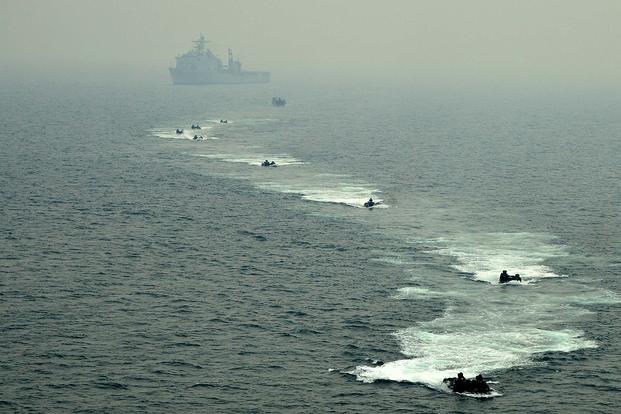The U.S. military is eyeing new spots in the Asia-Pacific region where it could forward-deploy troops and equipment to counter China's rise, the top commander overseeing operations in that region said this week.
With China rapidly developing new military capabilities and fortifying islands in the South China Sea, U.S. leaders are talking with partners and allies about where they might be able to send forces in the future, Adm. Phil Davidson, head of U.S. Indo-Pacific Command, told lawmakers Tuesday.
"So much of our basing and rotation has been focused on what's been transpiring in Northeast Asia, not just in the last couple of years, but really over the last several decades," Davidson said while testifying before the Senate Armed Services Committee. "This is going to require us to revisit some of the places in which we operate ... and rotate forces, absolutely."
The U.S. already rotates tens of thousands of troops through South Korea, Japan, Australia, Guam and other places in the region annually. Not only could some of those rotations expand, but experts say troops could also soon head to Indonesia, Papua New Guinea, Micronesia or other spots farther from Northeast Asia.
"There is a new mindset taking place in the region that, as China emerges as a near-peer, the U.S. is having to rethink its force structure in the region with the general tendency toward more presence in the region, stretching from maritime Southeast Asia to the Indian Ocean and away from Northeast Asia," said Carl Baker, executive director of the Pacific Forum at the Center for Strategic and International Studies.
As China builds up its naval and missile capabilities, the U.S. needs to find spots it can deploy its forces where they'll be safely out of reach. Better Chinese naval capabilities could put U.S. sailors and Marines into new sections of the Pacific or Indian Oceans, Baker said. And China's anti-access area denial capabilities could also push ground troops out toward the ends of the South China Sea.
One example of how the U.S. is thinking about repositioning came in the form of an announcement during the November Asia-Pacific Economic Cooperation former, said Dean Cheng, a senior research fellow at the Heritage Foundation's Asian Studies Center. China, which had expressed interest in building a naval base on Papua New Guinea's Manus Island, was pushed out. Instead, the U.S. and Australia teamed with the Papua New Guineans on the project.
Vice President Mike Pence said at the time of the announcement that the U.S. would work with Australia and Papua New Guinea to "protect sovereignty and maritime rights in the Pacific islands."
U.S. forces used a pair of naval facilities on Manus Island, which oversees two major shipping lanes, during World War II.
It will be impractical to establish permanent bases in most locations throughout Asia, though, Baker said. Troops are more likely to see bilateral and multilateral exercises in new locales, where they can work to improve interoperability with more partners during time of a crisis.
That seems to be what the U.S. is after in Micronesia, Cheng said. American leaders are talking to their counterparts there to see if they can use the islands as a staging ground in the event of a crisis, he said. Those islands are between Guam and Papua New Guinea.
Cheng said U.S. troops must also be mindful of Chinese space capabilities that allow it to monitor U.S. naval forces' movements or destroy satellites that allow communication between American vessels. Those are things U.S. troops didn't have to worry about while operating in Iraq or Afghanistan, he said.
All of this, Davidson told lawmakers, will require serious investment in new U.S. military capabilities, "from the bottom of the sea to space."
"We have to accept the fact that the environment is changing so drastically in the South China Sea that it's going to require new approaches in many cases, and not just iterative ones," he said.
-- Gina Harkins can be reached at gina.harkins@military.com. Follow her on Twitter @ginaaharkins.













